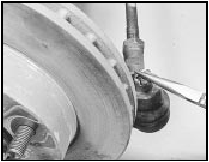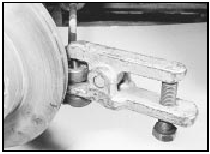Tie-rod end - removal and refitting
Note: A balljoint separator tool will be required for this operation.
Removal
1 Loosen the relevant front roadwheel nuts,
apply the handbrake, jack up the front of the
vehicle and support on axle stands.
2 Remove the roadwheel. On P100 models mark the position of the roadwheel in relation to one of the wheel studs before removal.
3 Make alignment marks on the tie-rod and tie-rod end, then loosen the locknut by a quarter of a turn.
4 Extract the split pin and unscrew the castellated nut (see illustration).

33.4 Extracting the split pin from the tierod balljoint castellated nut
5 Using a balljoint separator tool, release the tie-rod end from the hub carrier (see illustration).

33.5 Using a balljoint separator tool to release the tie-rod end from the hub
carrier
6 Unscrew the tie-rod end from the tie-rod, noting the number of turns necessary to remove it.
Refitting
7 Refitting is a reversal of removal, bearing in
mind the following points.
8 Screw the tie-rod end onto the tie-rod the number of turns noted during removal.
9 Tighten the nuts to the specified torque, and fit a new split pin to the castellated nut.
10 On P100 models, align the previously made marks on the roadwheel and wheel stud.
11 On completion, check and if necessary adjust the front wheel alignment.
See also:
Hydraulic unit pump and motor (ABS) - removal and refitting
Note: New sealing washers must be used on
the high pressure fluid hose banjo union, and
a new O-ring must be used between the
accumulator and the hydraulic unit on refitting.
Caution: Refer to the ...
Alternator drivebelt check (Every 6000 miles or 6 months)
1 A conventional vee drivebelt is used to
drive both the alternators and water pump
pulleys on OHV and HCS engines, and the
alternator pulley only on CVH engines, power
being transmitted via a pul ...
Cylinder head and pistons - decarbonising
OHV engines
1 With the cylinder head removed (Section 4),
the carbon deposits should be removed from
the combustion spaces using a scraper and a
wire brush fitted into an electric drill. Take care ...
